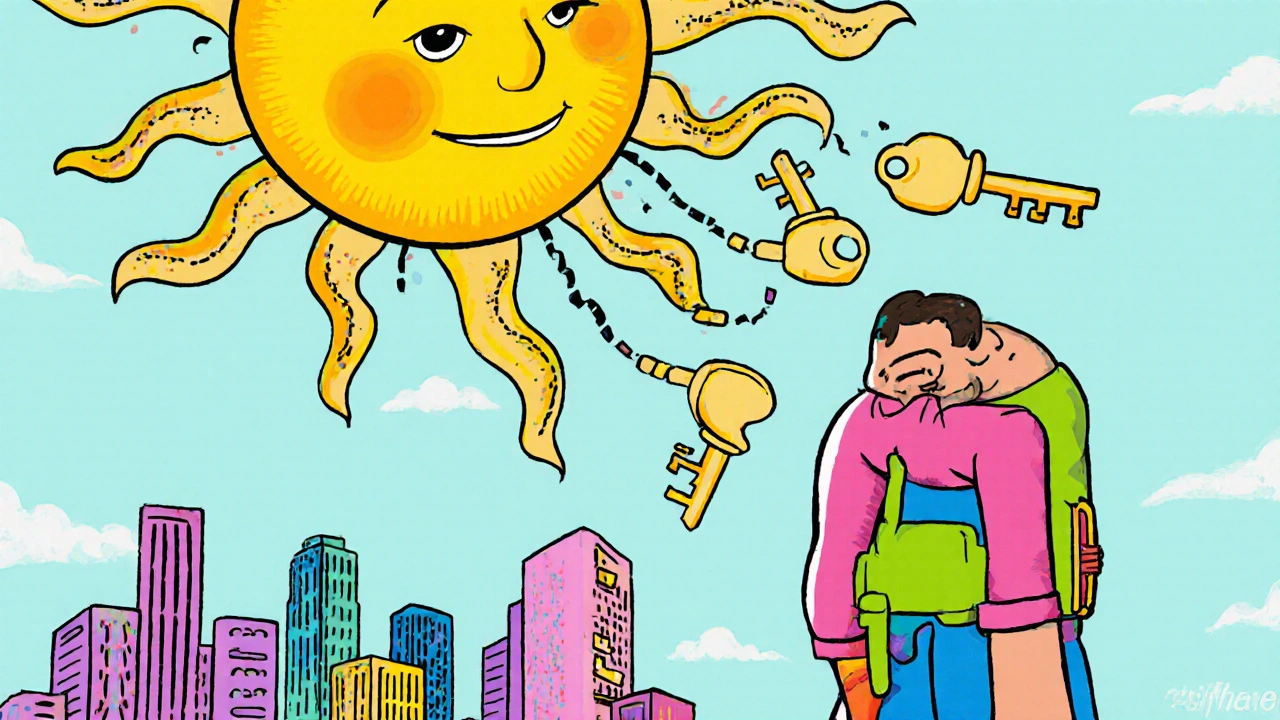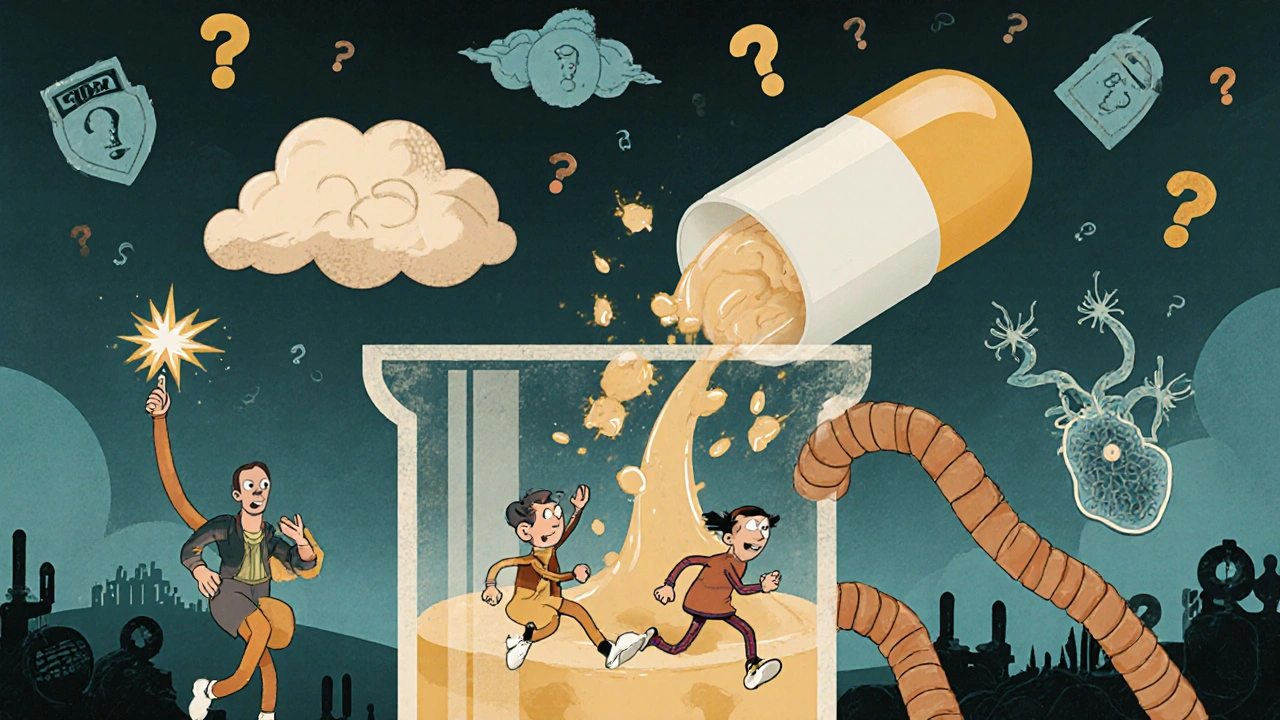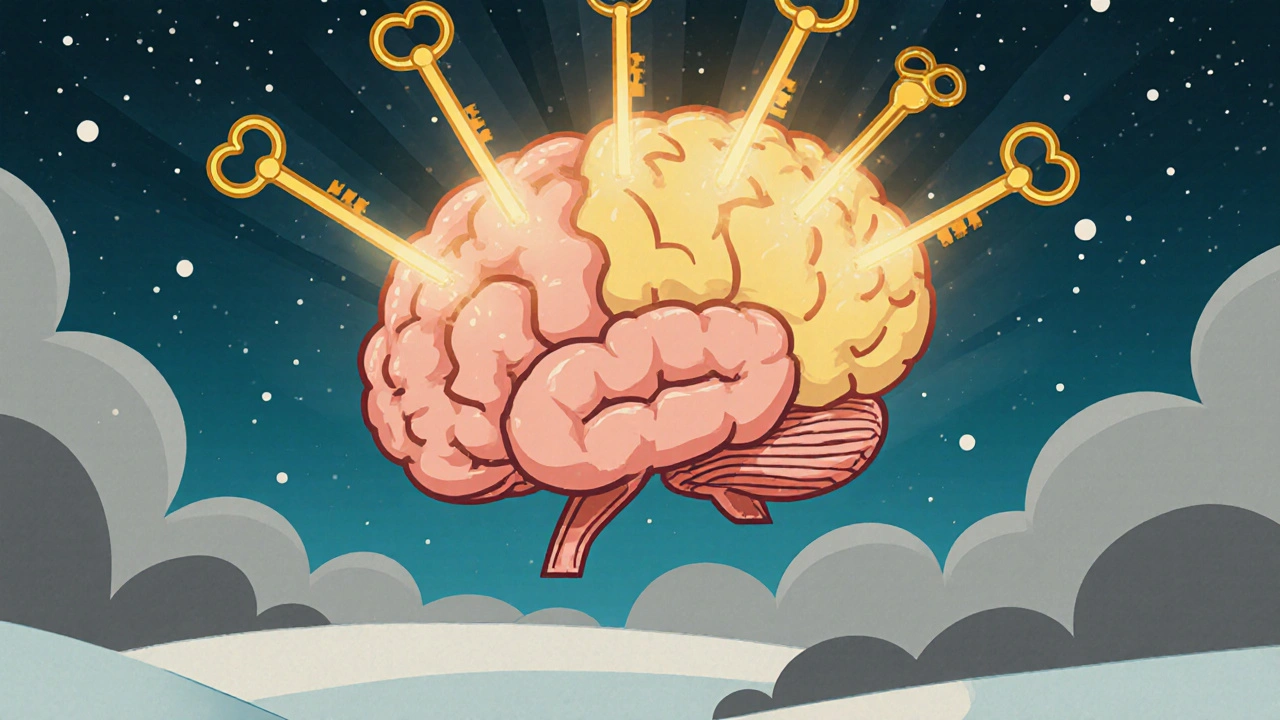For years, people have linked low sunlight and winter blues to depression. But what if the real issue isn’t just the lack of sun-it’s what your body stops making because of it? That’s where calcitriol comes in. This active form of vitamin D isn’t just for bones. It’s a powerful hormone that talks directly to your brain, and growing evidence shows it plays a key role in mood disorders like depression, anxiety, and seasonal affective disorder.
What calcitriol actually is-and why it’s not just vitamin D
When you hear "vitamin D," most people think of supplements or sunlight. But vitamin D3 from food or sun exposure isn’t active yet. Your liver turns it into 25-hydroxyvitamin D, and then your kidneys (and even your brain) convert that into calcitriol-the hormone your cells actually use. Think of it like a key that only fits one lock. Without calcitriol, your brain’s mood-regulating systems can’t function properly.
Unlike other vitamins that just help with metabolism, calcitriol acts like a messenger. It crosses the blood-brain barrier and binds to receptors in areas tied to emotion: the hippocampus, prefrontal cortex, and amygdala. These regions control memory, decision-making, and fear responses. When calcitriol levels drop, these areas don’t get the signals they need to stay balanced.
The link between low calcitriol and depression
Studies from 2020 to 2024 show a clear pattern: people diagnosed with major depressive disorder often have calcitriol levels 30% to 50% lower than those without depression. One large analysis of over 12,000 adults found that those with calcitriol below 20 ng/mL were twice as likely to report frequent feelings of sadness, hopelessness, or loss of interest.
This isn’t just correlation. In controlled trials, people with low calcitriol who took vitamin D supplements saw measurable improvements in their depression scores within 8 to 12 weeks. Not everyone responded-but those who did were the ones who started with the lowest levels. It’s not a magic cure, but for a significant group, it’s a missing piece.
How calcitriol influences brain chemistry
Calcitriol doesn’t just "boost mood" in a vague way. It directly affects three key brain systems:
- Serotonin production: Calcitriol activates the gene that makes tryptophan hydroxylase 2, the enzyme your brain needs to turn tryptophan into serotonin. Low calcitriol means less serotonin, which is why SSRIs (antidepressants that raise serotonin) are often prescribed.
- Neuroinflammation: Chronic inflammation in the brain is linked to depression. Calcitriol suppresses inflammatory cytokines like IL-6 and TNF-alpha. When levels drop, inflammation rises-and so does brain fog, fatigue, and low mood.
- Neuroprotection: Calcitriol helps grow new neurons in the hippocampus, the part of the brain that shrinks in long-term depression. Without it, the brain loses its ability to recover from stress.
One 2023 MRI study showed that people with low calcitriol had 7% less hippocampal volume compared to those with normal levels-even after adjusting for age, BMI, and activity levels. That’s not a small difference. It’s the kind of change you’d expect from years of untreated depression.

Seasonal affective disorder and the sunlight connection
Winter depression isn’t just about being cooped up inside. It’s about the drop in UVB rays, which your skin needs to make vitamin D. In northern latitudes, sunlight is too weak to trigger vitamin D synthesis from October to March. That’s why SAD rates spike during these months-and why light therapy works, but not for everyone.
People who respond best to light therapy are often the ones who also have the lowest calcitriol levels. In a 2024 trial, patients with SAD who got both light therapy and vitamin D supplements improved 40% faster than those who only used light. For some, calcitriol replacement was the difference between managing symptoms and falling into full-blown depression.
Who’s most at risk for low calcitriol and mood issues?
Not everyone with low vitamin D gets depressed. But certain groups are more vulnerable:
- People living north of 37° latitude: From Boston to Berlin, winter sunlight can’t trigger vitamin D production.
- Those with darker skin: Melanin blocks UVB rays. Black and South Asian populations need 3-6 times more sun exposure to make the same amount of vitamin D as lighter-skinned people.
- Older adults: Skin becomes less efficient at making vitamin D after 50. By 70, production drops by 75%.
- People with obesity: Vitamin D gets trapped in fat tissue, making it less available to the bloodstream.
- Those on certain medications: Steroids, anticonvulsants, and some weight-loss drugs interfere with calcitriol conversion.
If you fall into one or more of these groups and have struggled with low mood, fatigue, or brain fog, low calcitriol might be a factor-even if you don’t think you’re "vitamin D deficient."

Testing and fixing low calcitriol levels
Most doctors test 25-hydroxyvitamin D, not calcitriol. That’s because calcitriol levels fluctuate daily and are harder to measure. But here’s the catch: a normal 25(OH)D level doesn’t guarantee enough calcitriol. Some people convert vitamin D poorly due to kidney issues, genetics, or inflammation.
If you suspect low calcitriol is affecting your mood:
- Ask for a 25-hydroxyvitamin D blood test. Levels below 30 ng/mL are considered insufficient; below 20 ng/mL are deficient.
- If your level is low, start with 2,000-4,000 IU of vitamin D3 daily. Don’t take D2-it’s less effective.
- Take it with a meal containing fat. Vitamin D is fat-soluble and won’t absorb well on an empty stomach.
- Re-test after 3 months. Aim for 40-60 ng/mL.
- Consider adding magnesium. It’s needed to convert vitamin D into calcitriol. Many people are low in magnesium without knowing it.
Don’t go over 10,000 IU daily without medical supervision. Too much vitamin D can raise calcium levels and harm your kidneys.
What works-and what doesn’t
Calcitriol isn’t a replacement for therapy or medication. But for many, it’s the missing foundation. People who combine vitamin D with cognitive behavioral therapy (CBT) or antidepressants often report better results than with either alone.
What doesn’t work:
- Just taking a daily multivitamin. Most contain only 400-800 IU-far too little to fix a deficiency.
- Reliance on sunlight alone in winter. Even in sunny cities like Los Angeles, winter sun isn’t strong enough to trigger production.
- Assuming you’re fine because you eat fatty fish or fortified milk. You’d need to eat 10 servings of salmon daily to match 4,000 IU of supplements.
The real takeaway? Low calcitriol doesn’t cause all mood disorders. But it’s a major contributor for a large number of people-and it’s one of the easiest to fix.
When to talk to a doctor
If you’ve tried lifestyle changes and still feel stuck, ask for a blood test. Don’t wait for your doctor to bring it up-most still don’t screen for vitamin D unless you have bone pain or osteoporosis. But mood symptoms are just as valid a reason.
Also, if you’re already on antidepressants and feel like they’re not working, low calcitriol could be why. Some studies show that people with low vitamin D levels are 50% more likely to be resistant to SSRIs.
Fixing your calcitriol levels won’t erase trauma, chronic stress, or genetic risks. But it can give your brain the fuel it needs to heal-and that’s more than most people realize.
Can low calcitriol cause anxiety?
Yes. Low calcitriol is linked to heightened anxiety, especially in people with seasonal mood changes. It affects the amygdala-the brain’s fear center-and reduces GABA activity, a calming neurotransmitter. Studies show supplementing vitamin D can reduce anxiety symptoms, particularly in those with confirmed deficiency.
How long does it take for calcitriol to improve mood?
Most people notice subtle improvements in energy and focus within 2-4 weeks. Mood changes, like reduced sadness or irritability, usually show up after 6-12 weeks. Full brain effects, like improved memory or emotional resilience, can take 4-6 months. Consistency matters more than high doses.
Is calcitriol the same as vitamin D3?
No. Vitamin D3 is the raw material your body gets from sun or supplements. Calcitriol is the active hormone your liver and kidneys make from D3. You can’t buy calcitriol over the counter-it’s a prescription drug used for kidney disease. For mood, you take D3 and let your body convert it.
Can I get enough calcitriol from food?
Very little. Fatty fish like salmon and mackerel have some vitamin D3, but you’d need to eat 3-4 servings daily to reach 4,000 IU. Fortified foods (milk, cereal) typically add only 100-200 IU per serving. Sunlight and supplements are the only reliable sources for raising calcitriol levels.
Do I need to take calcitriol supplements?
No. Calcitriol supplements are only prescribed for kidney failure or rare genetic disorders. For mood, you need vitamin D3, not calcitriol. Taking calcitriol without medical supervision can dangerously raise blood calcium. Stick to D3 and get your levels checked.

Neil Mason
October 28, 2025 AT 23:35Man I’ve been feeling off all winter and I just thought it was the weather or working from home too much
Turns out my vitamin D was at 18 ng/mL
Took 4k IU daily with my dinner and honestly? Within 3 weeks I stopped dreading Mondays
Not cured but the fog lifted
Wish I’d known this sooner
Andrea Gracis
October 30, 2025 AT 16:43i had no idea vitamin d was actually a hormone?? like wow
so its not just for bones??
i thought i was just tired because i dont go outside enough
but now i think my brain was just starving
im getting tested next week
Matthew Wilson Thorne
October 31, 2025 AT 01:44Interesting. But let’s be honest-most people don’t need supplements. Just go outside.
April Liu
October 31, 2025 AT 06:19Thank you for writing this!! I’ve been on antidepressants for 2 years and felt like they weren’t doing much…
My doc never checked my D levels
Just got my results back-14 ng/mL
I started D3 yesterday and already feel a tiny bit more like myself
It’s not magic but it’s a start 😊
Emily Gibson
October 31, 2025 AT 23:13This is such an important post. So many people think depression is ‘just in your head’ but your brain is a physical organ that needs fuel
Calcitriol is like oxygen for your mood centers
If you’re struggling and haven’t checked your D levels, please do
You deserve to feel better
Mirian Ramirez
November 2, 2025 AT 09:48okay so i tried this last winter after reading some random blog and i took like 10,000 iu a day because i was desperate and i thought more is better
turns out my calcium went up and i got kidney stones
so yeah dont just mega dose
get tested first
and also magnesium is key i forgot that and felt worse
so take magnesium too
and dont be like me
Kika Armata
November 2, 2025 AT 10:52How predictable. Another vitamin D cultist ignoring the fact that correlation is not causation.
Did you control for socioeconomic status? Sleep quality? Light exposure duration? Social isolation? No, you didn’t.
And you’re recommending supplements to people who might have no deficiency at all? This is dangerous pseudoscience dressed up as medicine.
Herbert Lui
November 3, 2025 AT 20:16It’s funny how we’ve forgotten that our bodies evolved under sun, not fluorescent lights
We’re not meant to hibernate in cubicles from October to March
Our ancestors didn’t take pills-they moved with the seasons
Maybe the problem isn’t just low calcitriol
It’s that we’ve severed ourselves from the rhythm that made us
Sara Mörtsell
November 5, 2025 AT 18:16Okay but why is everyone acting like this is new news? This has been studied since the 90s
And why do people think supplements are a cure-all?
Also-magnesium? Really?
Everyone’s just throwing nutrients at the wall now
What’s next-zinc for existential dread?
Rhonda Gentz
November 6, 2025 AT 15:57There’s a quiet truth here: healing isn’t always loud
Some days you don’t feel better because you took a pill
But because you finally stopped blaming yourself for feeling broken
Calcitriol might help the chemistry
But the real work is learning you’re not broken to begin with
Alexa Ara
November 8, 2025 AT 00:07Just wanted to say-you’re not alone
I was skeptical too
But after 6 weeks of D3 + walking outside every morning
I started laughing again
Not because life changed
But because I finally had the energy to face it
Small steps. Big difference.
Olan Kinsella
November 8, 2025 AT 19:22Let me tell you something…
I lived in Lagos, Nigeria, then moved to Minnesota…
One year here and I was crying in the grocery store for no reason
My cousin said, ‘You’re not depressed, you’re vitamin-starved’
Turns out… he was right
My body was screaming for sun
And I didn’t even know how to listen
Now I take D3 and sit by the window like a plant
And I’m alive again
Kat Sal
November 9, 2025 AT 02:38Y’all are making this sound like a miracle cure
But it’s not-it’s a foundation
Like eating vegetables before you try a fancy diet
Do the basics first
Get tested
Take D3
Move your body
Sleep
Then come back to therapy or meds
Don’t skip the groundwork
Rebecca Breslin
November 10, 2025 AT 10:27Ugh I hate when people act like vitamin D is some secret hack
It’s not. It’s basic biology
And if you’re in Canada or the northern US and you’re not taking D3 in winter… you’re just being lazy
My grandma took it every day since the 70s
She’s 89 and still hikes in snow
Stop overcomplicating it
Kierstead January
November 12, 2025 AT 06:45So now we’re blaming depression on vitamin deficiency because it’s easier than admitting America’s mental health system is broken?
Fix the system, not the supplement.
And while you’re at it, stop pushing pills like candy.
It’s not empowerment-it’s corporate capitalism disguised as wellness.